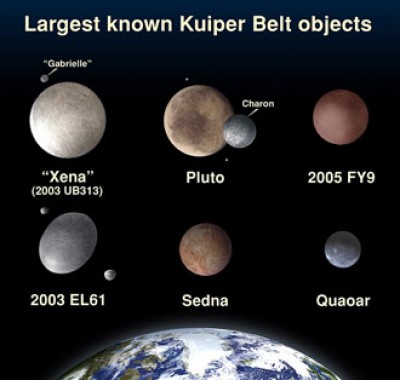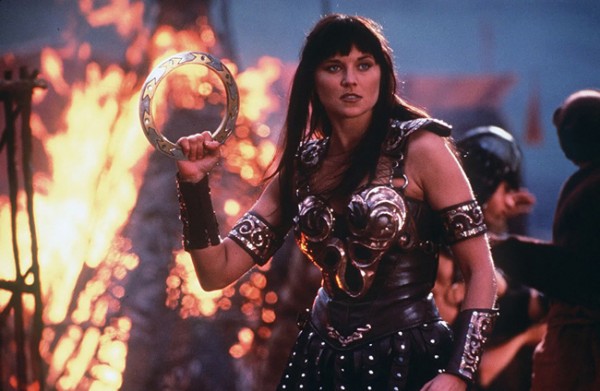Xena is the leading character of a television program called Xena: Warrior Princess, which ran from September 15, 1995 until June 18, 2001. Played by New Zealand actress Lucy Lawless, Xena is a fictional heroine who epitomizes the feminist movement, and has a following among transpeople, women, and men that cuts across Gay and Straight lines. In LGBTQ culture, Xena is a beloved Lesbian icon.
Background
The Bionic Woman, Wonder Woman, and Charlie’s Angels were television shows that offered strong, intelligent and beautiful warrior-like women decades before Xena, but without Lesbian subtext and innuendo. In addition to Xena, the show featured her sexy young confidant and frequent sleeping companion, Gabrielle, played by Renée O’Connor.
Xena: Warrior Princess was a spin-off from Hercules: The Legendary Journeys, wherein the Xena character was introduced during a three-episode story arc. Audience response was such that network executives quickly moved to develop a new show centered around the adventures of a scantily-clad martial-arts expert that was initially portrayed as a seductive yet vengeful vixen and evil warmonger. Originally, Xena was obsessed with defeating Zeus’ “Favorite Son” (Hercules) in order to claim the title of greatest living warrior, all while amassing a body count that rivaled those of any of her male counterparts.
After Hercules defeated and later befriended her, an epiphany inspired Xena’s evolution from murderous renegade outlaw to sympathetic public advocate, setting her on a journey of self-discovery seeking redemption for the many sins of her ruthless past. Fighting for the greater good, she became a protector of the innocent and most vulnerable. The stage was set for what would become the world’s most widely syndicated television program at that time, seen in more than 115 countries.
From Heroine-and-Sidekick to Crypto-Lesbian Lovers
Xena and Gabrielle’s relationship quickly became more sensual and bordered on the sexual. Increasingly common hints suggested that their relationship transcended mere friendship, that they shared a same-sex romantic relationship. This was never explicitly revealed on screen, but frequent cuddling, long embraces and, in the last season, a passionate kiss, alluded to such.
In the 13th episode of Season 2 (“The Quest”), Xena is seen leaning in to kiss Gabrielle from a dreamlike state, before cutting to Gabrielle kissing Autolycus, a male friend whose body Xena was inhabiting at the time.
Xena and Gabrielle may have flirted with men occasionally (Gabrielle was notorious for kissing men who would then die), but neither engaged in sexual relations with the men. Yet the series included two man-free pregnancies. As Xena’s and Gabrielle’s relationship progressed on screen, the terms used to describe it evolved in direct proportion to the intensity reflected in the storyline, from partners to friends, and then soul mates.

Gabrielle and Xena checking out Ares (Kevin Smith), God of War (celebarchive.net, sv.tinypic.com/view.php?pic=fee9ut&s=5, January 2013)
Outing Xena
During an appearance on Late Night With Conan O’Brien in June 2001 as she was promoting the two-hour finale, Lucy Lawless publicly outed her character as a Lesbian. Lawless told O’Brien that her alter-ego’s sexual orientation finally became clear to her while watching the final episode. “There was always an element of doubt in my mind,” Lawless revealed. “It didn’t matter to the way I played the role. So if the audience chose to see it or not … but I saw [the finale] for the first time last night and I went home and said to my husband [Xena Executive Producer Rob Tapert], ‘You’ve outed my character.’ I just … I can’t believe I’m saying this. I didn’t run this by anybody, but I don’t think there’s any doubt in my mind anymore.”
The final show was originally set in Greece, with Xena commissioning a poem from Sappho of the Isle of Lesbos as a gift for Gabrielle (Episode 19 of Season 6, “Many Happy Returns”). Liz Friedman, the show’s co-producer, is an openly Lesbian woman who regularly acknowledged the show’s girl-on-girl subtext. About Xena and Gabrielle’s relationship, Friedman said the following in the article, “Flirting with Xena”: “They’re such a perfect little butch-femme couple, what they do between episodes, I don’t know.”
Lesbian Camp
One of the elements that made Xena such a beloved pop icon was the underlying sense of humor that pervaded the series. This humor was what could best be described as Lesbian camp, the melodramatic seriousness of a warrior princess who encounters gods, fights demons, and flirts shamelessly with Gabrielle, all the while wearing sexy, impractical battle gear.
Both Friedman and Lawless extend the performance of Lesbian camp beyond the bounds of the scripted episodes. In “Flirting with Xena,” Friedman said she would date Xena without hesitation: “Xena’s perfect! She’s tough, smart, funny, and good with a sword.” For her part, Lawless said the following about Friedman: “Liz Friedman is gay? If I’d only known! She’s the first woman I’ve worshipped! I’d crawl 40 miles through broken glass just to wank off in her shadow!”
Xena-Mania
A proliferation of fan sites, fan fiction, syndicated reruns and DVDs have kept the series alive for millions of devotees around the world. Its influence remains vast, and even spawned its own fan fiction terms: altfic (“alternative fiction” or same-sex orientation fan fiction) and Uberfic (also known as UberXena, storylines in alternate universes and timelines). The appeal of sword-and-sorcery fantasy with Lesbian Warrior Princess camp sensibilities has led to events in which attendees, both male and female, come dressed as Xena and Gabrielle.

The Marching Xenas, 2001 NYC Pride Parade (smoe.org/meth/gallery/script.cgi?stext =&page=5&Show=Show&options=D&options=T&options=U, January 2013)
There is also a group called The Marching Xenas, fans who have participated in Pride parades. The Xena craze extended into the White House – when Condoleezza Rice was the US Secretary of State, she was given the nickname, “Warrior Princess.”
Planet Xena
A scandal erupted in the Hindu community when the sacred deity Krishna appeared on Xena, Warrior Princess in 1999. Although some were upset by Krishna being presented on what they deemed a Lesbian program, others were unhappy primarily because Krishna, the beloved Avatar of Vishnu, was reduced to an action hero for a non-Hindu television show.
Xena/Eris
The largest known dwarf planet in the Solar System, 136199 Eris (27% larger than Pluto and three times further away from the Sun) was initially named Xena by the team of men that found it. Team member and avid Warrior Princess fan Mike Brown described why in “Xena and Gabrielle” for Status, a newsletter on women in astronomy:
We always come up with code names for these things so we can keep mental track of them before they get real names. We had decided on code name Xena a long time ago for the first object we found bigger than Pluto. We chose it since it started with an X (planet ‘X’), it sounds mythological (OK, so it’s TV mythology, but Pluto is named after a cartoon, right?) and (this part is actually true) we’ve been working to get more female deities out there (i.e. Sedna)…I always joked that the reason we were going to use “Xena” was so I could meet Lucy Lawless. I didn’t actually get to meet her, but she did call to congratulate us. I don’t think we’d get that sort of kind response from some real Greek god, so I think we did good.

A brief moment in the stars: Planet Xena with its moon, Gabriella, April 2006 (nasa.gov/mission_pages/hubble/hst_xena_20060410.html, January 2013)
The single known moon was to be named “Gabrielle,” but both names were discarded because they were from recent popular American culture, not from any classical mythological pantheon. The dwarf planet is instead named after Eris, the Goddess of Strife. As a nod to Xena, the moon is called “Dysnomia” (“Lawlessness,” after Lucy Lawless), Eris’ daughter.
– Matt Kalkhoff and Mickey Weems
QEGF Authors and Articles
QEGF Introduction
Comments? Post them on our Encyclopedia facebook page.
Further reading:
Bagenal, Fran. “Xena and Gabrielle.” Status: A Report on Women in Astronomy. January 2006, p. 23.
Inness, Sherrie A. Tough Girls: Women Warriors and Wonder Women in Popular Culture. Philadelphia: University of Pennsylvania, 1999.
Keetley, Dawn. Public Women, Public Words. Lanham, MD: Rowman and Littlefield, 2005.
Stockwell, Anne. “Flirting with Xena.” The Advocate. August 20, 1996: 81-82.
Weisbrot, Robert. Xena, Warrior Princess: The Official Guide to the Xenaverse. New York: Doubleday, 1998.







